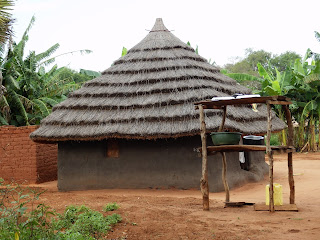
The huts are generally a single room and may be subdivided into a living and sleeping area by a curtain. The huts are generally clustered together around a central area. The doorways are generally covered by some form of net curtaining to reduce the ingress of insects, especially mosquitoes. Villages are encouraged to use mosquito nets for sleeping under but again the cost of purchasing these nets is often an issue. Sadly, the purchase costs are rarely balanced against the costs of treating malaria.
Latrines are either built for each hut or shared within a cluster of huts. Under the guidelines for establishing a "healthy homestead", latrines should be built a little distance from the huts and away from any water courses to reduce the risk of pollution. Outside the latrine, there should be a tippy-tap for hand washing.
Food is generally cooked on charcoal stoves which, in the rural areas, are constructed from the local clay. Smokeless stoves are expensive to purchase, though safer and more efficient to use. However, for the most families they are beyond their means. The charcoal stoves are either outside under a primitive cover or shared by villages within a separate hut. There is undoubtedly a high risk of carbon monoxide poisoning from the use of these stoves, as well as the wider dangers of spending significant time in very smoky environments. However, there appears to be little if any data collected on these risks.
However, despite villagers reluctance to invest in mosquito nets or smokeless cooking stoves, there is an increasing desire to purchase solar panels. The panels offer not just access to lighting but, and perhaps more desirable, television! In many cases, the solar panels are simply laid on the ground but some villagers, recognising that the panels will generate more power the greater the exposure to sunlight, are installing them on the roofs of their huts.







No comments:
Post a Comment